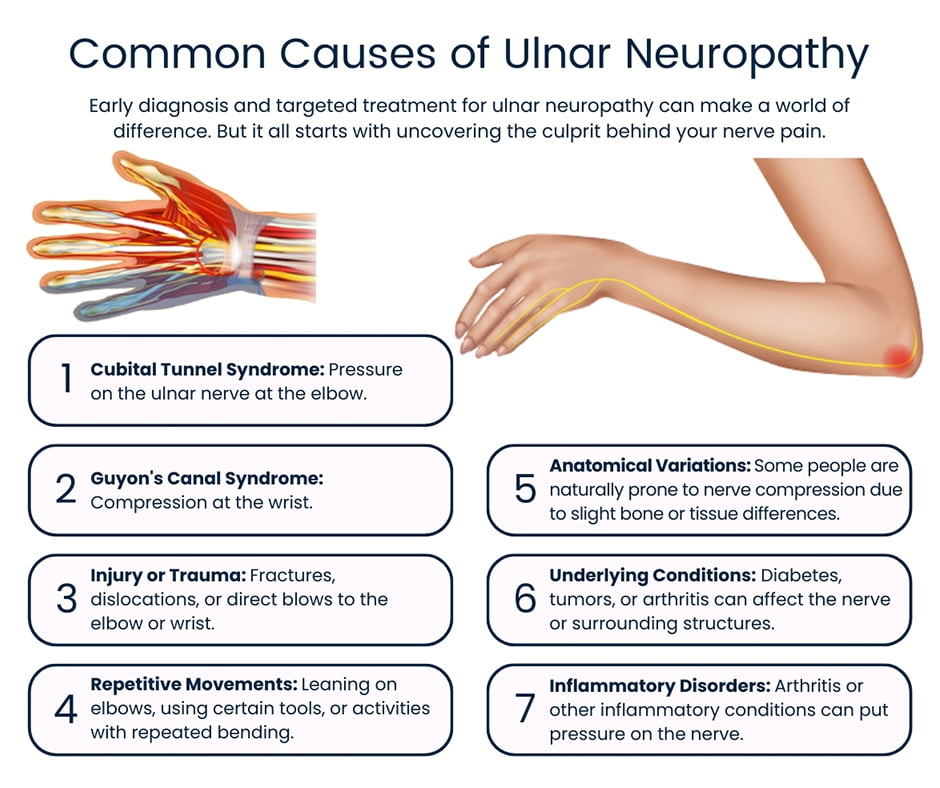Ulnar neuropathy mimics a lot of other painful conditions that affect your hands, fingers and wrists, which is why you need to seek treatment for ulnar neuropathy from an experienced nerve doctor. Find that team of specialists to correctly diagnose and provide the appropriate ulnar neuropathy treatments at Pain Management NYC. Call today before you suffer from more serious consequences that may not be able to be reversed.
What Is Ulnar Neuropathy?
Ulnar neuropathy, also known as ulnar nerve entrapment or ulnar nerve compression, is a pinching of the ulnar nerve. The ulnar nerve provides feeling to your little finger and part of your ring finger on each hand. It also controls some hand muscles. Cubital tunnel syndrome is the most common type of ulnar nerve compression neuropathy.
Pain Management NYC is a New York City-based practice with a diverse group of skilled experts. The experienced team of doctors specializes in treating a wide range of nerve pain. Their treatment plans rely on the latest advancments in technology with each plan tailored for your specific needs.
In addition to ulnar neuropathy treatments, they also treat other conditions, such as:
- Diabetic neuropathy
- Peripheral neuropathy
- Compression neuropathy
- Tarsal tunnel syndrome
- Peroneal nerve disorders
- Chronic headaches
- Carpal tunnel syndrome
What Are the Symptoms of Ulnar Neuropathy?
Signs that you may have ulnar neuropathy vary widely, and it’s the severity of your symptoms that your doctor seeks to understand when evaluating the extent of your nerve compression.
Commonly observed symptoms include:
- Tingling and numbness, primarily in the little and ring fingers on the side affected
- Hand weakness, which impairs grip strength and fine motor control
- Certain movements that aggravate pain along the inner side of the forearm or in the hand
- Impaired coordination that results in difficulties with precise finger movements
- Increased clumsiness because of a weakening grip and poor control
- Reduced muscle size and strength in the affected hand
- Pain or discomfort at the location of nerve compression, such as the inner elbow or wrist
If ulnar neuropathy isn’t treated, it can progress to more severe and potentially irreversible symptoms.
Complicated symptoms associated with ulnar neuropathy include:
- Persistent weakness
- Muscle atrophy
- Loss of fine motor skills
- Chronic pain
- Permanent nerve damage
- Functional limitations
What Causes Ulnar Neuropathy?
Early identification and effective treatment for ulnar neuropathy can result in positive outcomes, as long as your nerve pain specialist clearly identifies the cause of the nerve pain. The first step is to figure out if there’s an underlying condition that led to your condition.
Recognizing and managing the underlying cause of ulnar neuropathy is important for ulnar neuropathy treatment.
While the condition is usually caused by ulnar nerve compression or injury, common causes of the impairment include:
- Cubital tunnel syndrome (CTS), which is defined as compression of the ulnar nerve at the elbow, known as cubital tunnel syndrome
- Guyon’s canal syndrome that’s compression of the ulnar nerve at the wrist
- Injury or trauma from a direct elbow or wrist fracture or dislocation
- Repetitive movements involving elbow or wrist bending, such as frequent leaning on your elbow or repeated impacts from working with certain tools
- Variations in anatomy, as you may be prone to ulnar nerve compression due to a mild deformity
- Underlying medical conditions, such as diabetes or tumors near the ulnar nerve
- Inflammatory disorders such as arthritis that impact the ulnar nerve’s joints or nearby tissues

How Is Ulnar Neuropathy Diagnosed?
Successful treatment for ulnar neuropathy depends on the diagnosis made. A combination of medical history, physical examination and specialized testing is used to diagnose ulnar neuropathy. These diagnostic techniques work together to help your doctor determine the severity and causes.
A general overview of the diagnostic process includes:
- Physical assessment. The strength, feeling and reflexes in the affected area are evaluated.
- Tinel’s exam. Tapping on the ulnar nerve induces tingling and helps in the diagnosis of nerve irritation or compression.
- The Phalen test. This is a wrist flexion test to produce or aggravate symptoms, which helps in the diagnosis of wrist-related compression.
- Nerve conduction studies. Electrical impulses from the ulnar nerve are measured to determine speed and strength, as well as to discover compression or injury.
- Electromyography. Muscle electrical activity is measured to detect muscle involvement and nerve injury.
- Imaging studies. An MRI or ultrasound is done to examine structures surrounding the ulnar nerve and detect probable compression sources. X-rays are used to evaluate the bone structures around the elbow and wrist for signs of abnormalities.
The prognosis for ulnar neuropathy varies depending on the cause of the condition, the severity and how quickly ulnar neuropathy treatments are implemented. Several factors can increase your chance of developing ulnar neuropathy.
Notable risk factors include:
- Being overweight
- Sleeping with your elbow bent for extended periods
- Age, as adults are more prone to ulnar neuropathy
- Gender, since men develop ulnar neuropathy more often
What Are the Available Ulnar Neuropathy Treatments?
Mostly ulnar neuropathy treatment is determined by the root cause and the intensity of your symptoms.
General treatment for ulnar neuropathy typically involves:
- Splinting or bracing. Wearing a brace or splint keeps the elbow upright, especially when sleeping.
- Physical therapy. Specific exercises target the muscles controlled by the ulnar nerve to enhance strength, flexibility and posture, as well as to reduce discomfort.
- Anti-inflammatory medicines. Nonsteroidal anti-inflammatory medications, such as ibuprofen and naproxen, relieve inflammation and pain.
- Steroid injections. Injections of corticosteroids into the region that’s affected reduce inflammation and provide temporary relief.
- Weight management. Maintaining a healthy weight relieves excessive stress on the nerves.
- Surgery. When traditional treatments fail, or symptoms become severe, surgical procedures may be considered. Surgical techniques aimed at relieving strain on the ulnar nerve include cubital tunnel release and wrist decompression.
Depending on the circumstances and underlying causes, ulnar neuropathy treatment may involve multiple specialists.
Specialists who may be engaged in the care of ulnar neuropathy include:
- Neurologists, who are nervous system specialists performing thorough examinations and orders nerve testing to determine nerve damage
- Orthopedic surgeons, who perform treatments such as cubital tunnel release for nerve compression
- Physical therapists, who teach you exercises to improve strength, flexibility and general hand and arm function
- Occupational therapists, who help you return to doing your daily activity skills and provide strategies for task management despite ulnar neuropathy limitations
- Rheumatologists, who you consult for autoimmune or inflammatory ulnar neuropathy
- Hand therapists, to focus on hand and upper body recovery and offer strategies that improve hand function and relieve symptoms
The team at Pain Management NYC provides you with the spectrum of services you need to accurately diagnose and effectively treat ulnar neuropathy and other nerve disorders. Contact Pain Management NYC immediately to begin the best treatment for ulnar neuropathy and return to your regular daily activities.

Leon Reyfman, MD, is a top-rated, best-in-class interventional pain management doctor. He is a nationally recognized pain relief specialist and is among the top pain care doctors in New York City and the country. He is an award-winning expert and contributor to prominent media outlets.
Dr. Leon Reyfman has been recognized for his thoughtful, thorough, modern approach to treating chronic pain. He has been named a “top pain management doctor in New York” and one of “America’s Top Doctors™” for advanced sports injury treatments. Among other accolades, he was voted by peers as a “Castle Connolly Top Doctors™” and “New York Super Doctors™”. Dr. Leon Reyfman was a part of the medical team at the 2016 Summer Olympic Games in Rio de Janeiro, Brazil.
